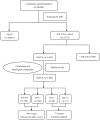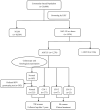Efficient combination of Human Papillomavirus Genotyping for the triage of women with Atypical Squamous Cells of Undetermined Significance in Chinese rural population: A population-based study
- PMID: 33854582
- PMCID: PMC8040879
- DOI: 10.7150/jca.55771
Efficient combination of Human Papillomavirus Genotyping for the triage of women with Atypical Squamous Cells of Undetermined Significance in Chinese rural population: A population-based study
Abstract
Objective: In this prospective, population-based study, we evaluated the utility of high-risk human papillomavirus (HR-HPV) genotyping for triaging women with atypical squamous cells of undetermined significance (ASC-US) in the Chinese rural area. Methods: A total of 40,000 women were recruited from rural areas of Shanxi Province, China, between June 2014 and December 2014. Women with Pap results of ASC-US underwent HPV genotyping, colposcopy and histopathological examination. For those with normal cervixes or cervical intraepithelial neoplasia (CIN) 1 on the initial evaluation, a 2-year follow-up study was performed. Results: The reporting rate of ASC-US was 5.76% (2,304/40,000) in the study population. The detection rates of CIN 2 or above (CIN2+) and CIN 3 or above (CIN3+) in women with ASC-US were 7.28% and 1.75%, respectively. HPV 16 (39.53%), HPV 58 (17.83%), and HPV 52 (15.50%) were the three most prevalent HR-HPV genotypes among all women with ASC-US cytology. The five most common HR-HPV genotypes in CIN3+ lesions were HPV16, HPV58, HPV33, HPV31 and HPV18. Compared with the 15 HR-HPV testing, genotyping for a combination of HPV16/18/31/33/58 increased specificity significantly with virtually no loss of sensitivity for detecting CIN2+ and CIN3+ lesions, as well as significantly reduced colposcopy referral rate (23.15% vs 33.70%, p<0.01). In addition, in the 2-year follow-up period, women with infection of HPV16, 18, 31, 33 or 58 genotypes were the most likely population (92%, 23/25) to develop CIN2 lesion. Conclusion: Our results demonstrate that genotyping for a combination of HPV16/18/31/33/58 provides a more efficient and cost-effective model to risk-stratify women with ASC-US in the Chinese rural population.
Keywords: Atypical Squamous Cells of Undetermined Significance (ASC-US); Human Papillomavirus (HPV) genotyping; Pap test; cervical cancer screening; cervical intraepithelial neoplasia.
© The author(s).
Conflict of interest statement
Competing Interests: The authors have declared that no competing interest exists.
Figures


Similar articles
-
Comprehensive overview of genotype distribution and prevalence of human papillomavirus in cervical lesions.Gynecol Obstet Clin Med. 2024 Apr;4(1):e000005. doi: 10.1136/gocm-2024-000005. Gynecol Obstet Clin Med. 2024. PMID: 38650896 Free PMC article.
-
[Evaluation of CIN2+ /CIN3+ risk of different HPV subtypes infection combined with abnormal cytology status].Zhonghua Zhong Liu Za Zhi. 2018 Mar 23;40(3):232-238. doi: 10.3760/cma.j.issn.0253-3766.2018.03.015. Zhonghua Zhong Liu Za Zhi. 2018. PMID: 29575846 Chinese.
-
The Triage Effectiveness of an Extended High-Risk Human Papillomavirus Genotyping Assay for Women with Cytology Showing Atypical Squamous Cells of Undetermined Significance in China.Risk Manag Healthc Policy. 2020 Sep 24;13:1747-1756. doi: 10.2147/RMHP.S270265. eCollection 2020. Risk Manag Healthc Policy. 2020. PMID: 33061708 Free PMC article.
-
The effectiveness of HPV16 and HPV18 genotyping and cytology with different thresholds for the triage of human papillomavirus-based screening on self-collected samples.PLoS One. 2020 Jun 11;15(6):e0234518. doi: 10.1371/journal.pone.0234518. eCollection 2020. PLoS One. 2020. PMID: 32525936 Free PMC article.
-
Evidence regarding human papillomavirus testing in secondary prevention of cervical cancer.Vaccine. 2012 Nov 20;30 Suppl 5:F88-99. doi: 10.1016/j.vaccine.2012.06.095. Vaccine. 2012. PMID: 23199969 Review.
Cited by
-
High-risk human papillomavirus genotyping in women with atypical squamous cells of undetermined significance.Sci Rep. 2023 Jul 26;13(1):12134. doi: 10.1038/s41598-023-39206-2. Sci Rep. 2023. PMID: 37495771 Free PMC article.
-
Analysis of the related factors of atypical squamous cells of undetermined significance (ASC-US) in cervical cytology of post-menopausal women.Front Cell Infect Microbiol. 2023 Feb 16;13:1123260. doi: 10.3389/fcimb.2023.1123260. eCollection 2023. Front Cell Infect Microbiol. 2023. PMID: 36875525 Free PMC article.
-
Comprehensive overview of genotype distribution and prevalence of human papillomavirus in cervical lesions.Gynecol Obstet Clin Med. 2024 Apr;4(1):e000005. doi: 10.1136/gocm-2024-000005. Gynecol Obstet Clin Med. 2024. PMID: 38650896 Free PMC article.
References
-
- Davey DD, Souers RJ, Goodrich K, Mody DR, Tabbara SO, Booth CN. Bethesda 2014 Implementation and Human Papillomavirus Primary Screening: Practices of Laboratories Participating in the College of American Pathologists PAP Education Program. Archives of pathology & laboratory medicine. 2019;143:1196–202. - PubMed
-
- Stoler MH, Wright TC Jr, Sharma A, Apple R, Gutekunst K, Wright TL. High-risk human papillomavirus testing in women with ASC-US cytology: results from the ATHENA HPV study. American journal of clinical pathology. 2011;135:468–75. - PubMed
-
- College of American Pathologists, Cytopathology Checklist, Northwestern Memorial Hospital Laboratories. 2017; (CAP Number 1870801)
-
- Zheng B, Yang H, Li Z, You J, Wei G, Zhang H. et al. Atypical Squamous Cells of Undetermined Significance Cervical Cytology Report Rate and Histologic Follow-up Findings From the Largest College of American Pathologists-Certified Laboratory in China. Archives of pathology & laboratory medicine. 2019;143:748–52. - PubMed
-
- Tao X, Austin RM, Kong L, Sun Q, Lv Q, Xu H. et al. Nationwide survey of cervical cytology laboratory practices in China. Journal of the American Society of Cytopathology. 2019;8:250–7. - PubMed
LinkOut - more resources
Full Text Sources
Other Literature Sources
Research Materials
Miscellaneous

